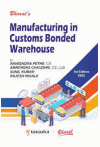- Author(s): Raveendra Pethe, Amrendra Chaudhri, Sunil Kumar, Rajesh Ingale
- Publisher: Bharat Law House
- Edition: 1 Ed 2022
- ISBN 13 9789394163188
- Approx. Pages 640 + Contents
- Format Paperback
- Approx. Product Size 24 x 16 cms
- Delivery Time 3-5 working days (within Kerala & South India) (Others 7-9 days)
- Shipping Charge Extra (see Shopping Cart)
............................................................................................
Description
Customs bonded warehouse (private/public) is an age-old concept in international trade. In such warehouses, imported goods can be stored for a specified period without payment of customs duty. Private bonded warehouses, in addition, may be permitted to carry out manufacturing and other operations by the jurisdictional customs authorities.
The Indian Customs Law has, since its inception, recognised manufacturing in the customs bonded warehouse. The Government further simplified the warehousing provisions in 2019 in line with the globally accepted framework. This, presumably, is in the backdrop of the likely reconsideration of EOU, SEZ, EPCG, and other such schemes. Therefore, a unit licensed under the Manufacturing and Other Operations in Warehouse Regulations ('MOOWR') could be a suitable alternative to units under existing schemes to neutralise the customs duty in international supply chains. MOOWR scheme allows a manufacturer to save the cost of working capital by postponing the customs levy on inputs till the removal of resultant goods and on capital goods till such goods are removed for home consumption. There is no obligation to export, and the unit can be located anywhere in India. However, MOOWR is yet to catch the imagination of the business community at large. The revised MOOWR scheme, being in a nascent stage, has apprehensions in trade at large due to a lack of clarity in some of the compliance aspects and benefits vis-a-vis the existing schemes. Although the Government is open to resolving the difficulties by issuing circulars and FAQs, there are some open issues that could be critical for business decisions. Despite the open issues, the MOOWR scheme is worth evaluating by the trade for the manufacturing sector considering potential benefits, including the transition from existing schemes such as EOU, SEZ, EPCG, AA, drawback, etc. This calls for a comparative analysis based on relevant parameters, including cost-benefit. To support such research, a comparative chart of various schemes is provided in the book.
.........................................................................................
Contents
Chapter 1. Customs Bonded Warehouse
Chapter 2. Public Bonded Warehouse
Chapter 3. Private Bonded Warehouse
Chapter 4. Special Bonded Warehouse
Chapter 5. MOOWR unit
Chapter 6. MOOWR unit in Special Warehouse
Chapter 7. Setting up a Warehouse or a MOOWR Unit
Chapter 8. Application Form
Chapter 9. Procurement in a Warehouse & MOOWR Unit
Chapter 10. Clearances from Warehouses
Chapter 11. Compliances & Management
Chapter 12. License: Cancellation & Exit
Chapter 13. Business Opportunities in a Bonded Warehouse and MOOWR Unit
Chapter 14. Authors' FAQs
Chapter 15. Comparison of various import export schemes
Chapter 16. FAQS by Public Authorities
Chapter 17. Customs Regulations
Chapter 18. Circulars, Instructions, Public Notices, etc.
Chapter 19. Miscellaneous
Chapter 20. Forms for Application, Records & Returns
SUBJECT INDEX
............................................................................................
Author Details
Raveendra Pethe, CA
Amrendra Chaudhri, CS, LLB
Sunil Kumar
Rajesh Ingale

